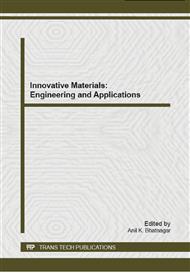[1]
Xu Hongxiang, Computation of different cone structure anti icing [D], Tianjin: Tianjin University, 2007. 6.
Google Scholar
[2]
Zhang allegiance Bairuo Yang, Jiang Aimin. Constitutive relations and compressive strength of sea ice research [J]. Mechanics in Engineering, 2009, 36(06): 50-52.
Google Scholar
[3]
Chen Weibin, Numerical simulation of sea ice and isolated pile interaction [J]. Oceanography (Chinese version), 1996, 18(04): 114-119.
Google Scholar
[4]
Wu Wenhua, in Bai Jie, Yue forward, and so on. JZ20-2NW platform for anti-ice performance finite element analysis [J]. Chinese offshore platforms, 2007, 22 (06): 25-28.
Google Scholar
[5]
Li Fucheng, Mengguang Lin, Zhang Mingyuan, etc. Study on the Strength of Bohai sea ice [J]. Oceanography, 1987, 9 (02) : 255-261.
Google Scholar
[6]
Song Weidong, Ning Jianguo, The ice force on off shore structures critical [J]. Journals of Glaciology and Geocryology, 2003, 25(03): 351-354.
Google Scholar
[7]
Yue Qianjin, Bi Xiangjun, Ice induced vibration and ice force function of conical structure [J]. China Civil Engineering Journal, 2003, 36(02): 16-19.
Google Scholar
[8]
Ralston TD. Ice force design consideration for conical offshore structures[C]. Proceedings of the 4th International Conference on Port and Ocean Engineering under Arctic Condition (POAC77), Vol. 2 Canada, 1977, 741-752.
Google Scholar
[9]
Wang Bin. Liaodong Bay seawater and platform interaction studies [D] Beijing: China University of Petroleum, (2011).
Google Scholar
[10]
Li Zhijun, high tree Kong, Yan Decheng, etc. Bohai Sea ice thickness flat partition statistics [J]. Chinese offshore oil and gas projects, 1996, 8 (01) : 43-46.
Google Scholar
[11]
Li Zhijun, Wang Yongxue, The design parameters of Bohai sea ice engineering [J], The Ocean Engineerin, 2000, 18(01): 61-64.
Google Scholar
[12]
Zufelt J E, R E ttema. Model ice properties[R], CRREL Report 96-1. Cold Regions Research and Engineering Laboratory, Hanover, New Hampshire, USA. 1996. 25.
Google Scholar
[13]
Li Zhijun, Zhang Mingyuan, Meng Guanglin, Experimental study on adhesion strength of the frozen sea ice and building materials[J], marine environmental sciences , 1992. 11(2): 79-83.
Google Scholar


